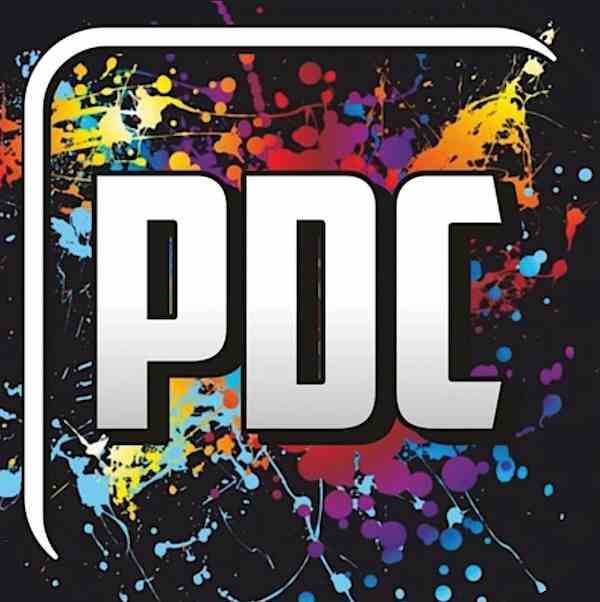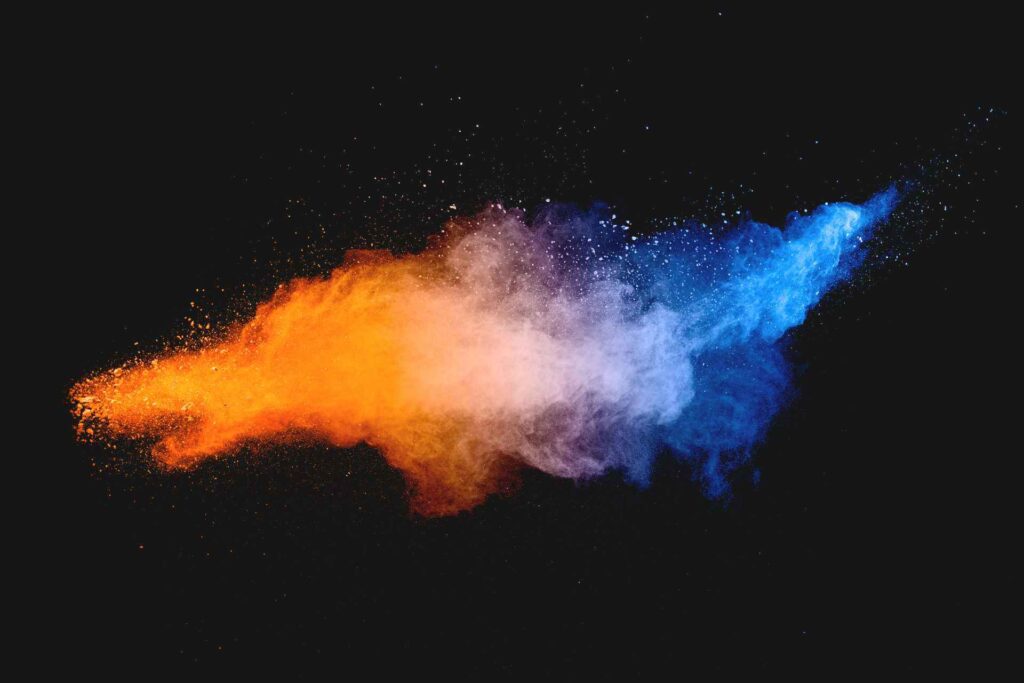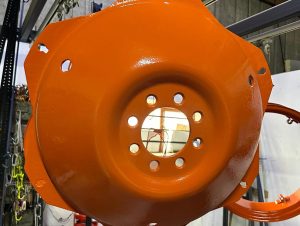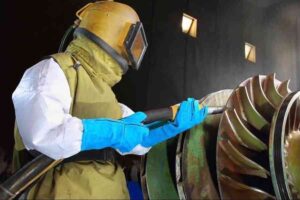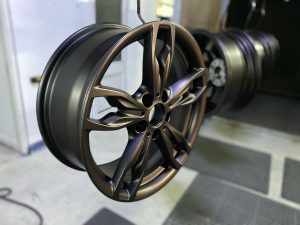Providing a finish for vehicles and equipment pieces does more than give them a pleasing colour or texture. It’s often necessary to properly protect these objects for many years and help them stand up to their environments, from weather to chemical exposure.
Powder coatings grant a range of benefits beyond just being aesthetically pleasing. For longevity, finish, and durability, these alternatives to traditional liquid paint can’t be beaten, and there are many options to choose from.
What exactly is powder coating?
Powder coating is a form of finishing that is used as an alternative to liquid paint. It’s applied as a polymer powder that clings to its substrate (the item to be coated) electrostatically.
For this reason, it’s usually used for metal objects such as vehicles and machinery, tools, and pieces of architecture. The metal substrate is grounded and the powder is applied used a special gun that applies an electrostatic charge to the particles. This causes them to cling fast to the metal until the powder can be cured.
When cured, the powder turns from particles into an even, consistent finish that covers the part in a uniform coat. This is achieved in slightly different ways depending on whether the coating is a thermoplastic powder or a thermoset powder.
Thermoplastic powders have a lower melting point than thermoset powders and can be reheated after curing, making them ideal if you want to use recyclable materials wherever possible. They also don’t form chemical bonds during the curing process, lending to their ability to be remoulded.
Thermoset powders, on the other hand, form a chemical bond that sees them stay strong and uniform even under high heat. This makes them generally tougher than thermoplastics, but sacrifices their ability to be recycled.
Powder coatings vary in the types of plastics utilised to create them, and include:
Epoxies
Epoxy powders boast great chemical resistance and general durability. They’re easy to use and are suitable for a wide range of contexts, but suffer from worse UV resistance when compared to other types of powders. Epoxy coatings also offer electrical insulation.
Prolonged exposure to sunlight can cause them to chalk, which fades their colour and affects their finish and durability. For this reason, they’re generally better for indoor use than outdoor. This can be somewhat countered by using epoxies as primers, lending their benefits whilst mitigating their weakness against UV.
Polyester
Polyesters are good all-round powders and are widely used for a variety of applications. They’re flexible and versatile, able to be used in a broad range of colours and textures.
Polyester powders also have relatively low cure temperatures, which makes them ideal for items and surfaces that are more heat sensitive.
Polyester powders can be used both indoors and outdoors to some degree, and while not as sensitive to UV as epoxy powders, they’re still mostly suited for indoor environments.
Epoxy-polyester hybrid
Epoxy and polyester powders are often mixed in various ratios in order to combine their properties. Typically, this combination is used so that the qualities of the polyester can smooth over the drawbacks of epoxy.
This lends the impact resistance and flexibility of polyester to epoxy, as well as helping the coating perform better in the outdoors.
Super durable polyester
These upgraded powders have become a highly popular alternative to standard polyester. Their durability is enhanced with better resistance to corrosion, lending them longer-lasting gloss and colour. Super durable polyesters are better for outdoors use than standard polyester coatings.
Super durable polyester powder coatings resist humidity, abrasion, and chemicals with high performance, while still boasting the range of colours and finishes that make polyester so popular.
Fluoropolymers
For outdoor applications, fluoropolymers are one of the best powders available. They boast excellent weatherability and resistance, making them often the superior choice for powder coatings that need to retain their colour and finish for a long time despite facing the elements.
Fluoropolymers like PTFE are lubricious and low friction, making them easier to maintain as well as helping their already-fantastic resistance to chemicals, abrasion, and corrosion.
There are many types of powder coatings beyond these that differ in subtle ways, but using an expert powder coating provider ensures you get the best type for your specific needs.
What is powder coating used for?
Powder coating is used in many of the same ways that paint has traditionally been used to coat and protect objects.
It can be used in a variety of industries from automotive to agriculture to architecture. Food grade powder coatings can be used to finish kitchen items, and certain textures of coating can be achieved to make them useful for gripping and holding as well as lending aesthetic and sensory appeal.
Rather than being simply decorative, powder coatings are typically more applicable to situations where their substrates will face higher wear and tear, such as on outdoor vehicles and objects that are subject to continued weather and UV exposure.
Accordingly, powder coatings are best for objects that need to be protected from the elements but can’t easily be protected in any other way, such as large structures and public seating.
Due to its ability to be cured with a grainer texture, powder coatings might also be used specifically in situations wherein the glossy finish of liquid paint would be unsuitable or even hazardous.
A powder coating can be used on small components as well as large objects, and is often used to coat parts before use so that they enjoy extra protection and resistance. The mechanical properties of the coating may also make the part easier to use, such as fluoropolymer coatings making threaded parts easier to turn.
Benefits of powder coating?
One of the biggest benefits of using powder coating is that, unlike paint, it doesn’t rely on a carrier fluid.
These fluids, known as solvents, often contain volatile organic compounds (VOCs). VOCs are chemicals that are harmful to those who are exposed to them, and can cause dizziness and headaches as well as irritation to the eyes, throat, and lungs. As paint dries, VOCs are released into the air.
The benefits of this lack of VOCs extends throughout the lifespan of the coating, as paint which chips and flakes off its substrate over time can contaminate soil—particularly in the case of lead-based paints like those that can be found on external walls and metal surfaces.
Another advantage to powder coatings is that they’re a dry medium, and are cured using heat or UV light. As such, they don’t need to off-gas solvents and are much easier to apply in uniform layers, since they won’t drip like liquid paint. It’s also easier to apply in thicker coatings for this reason, without the risk of sagging.
Arguably, one of the biggest benefits to powder coating is its durability and hardiness. A cured powder coating, depending on the type of coating used, can offer high UV and heat resistance, resistance to chalking, abrasion resistance, and more.
With this higher level of resistance, coupled with the fact that powder coatings are not flammable once cured, comes the knowledge that it’s a much more reliable and all-round safer option than liquid paints.
Properly maintained and cared for, powder coatings can last upwards of twenty years. This extends to the substrates they protect, meaning metal objects can enjoy many years of protection from rust and corrosion.
What are the disadvantages of powder coating?
Powder coating isn’t typically suited for wooden or plastic objects due to the need for electrostatic attraction of the particles.
Poor application of powder coating can also create undesirable finishes, such as an effect known as ‘orange peel’. This occurs when powder coverage is too thick, making the texture of the resulting finish uneven and pocked, similar to the skin of an orange.
Given the need to cure a coated part as a whole, powder coating is somewhat restricted by the size of its substrates. For certain surfaces, liquid paint will prove to be a more practical option than powder coating.
Powder coatings cannot simply be applied by anybody; the need for specialised equipment like static guns and curing ovens, as well as the care and attention needed in applying the powders evenly, means that powder coating is best left to a professional. As such, it isn’t as accessible for the DIYer as paint is.
Additionally, powder coating demands thorough pre-treatment of the substrate before applying. While this isn’t a specific setback of powders themselves, as using traditional paint would ideally demand the same, it does mean that metals can’t simply be coated and cured. They must be thoroughly cleaned of any previous finish, as well as dirt and grime, grease and oil, and anything else that might affect the powder’s ability to adhere and cure evenly.
What is the life expectancy of powder coating?
The longevity you can expect from a powder coating varies depending on the type of powder used, the environment it’s subjected to, and how much its various resistances are tested on a regular basis.
Let’s find out how long does powder coating last. Some powders won’t last as long as they could if used in situations where they don’t excel, like using epoxy coatings in high UV environments.
Additionally, the life expectancy of a powder coating relies as much on competent preparation before the application as it does on regular cleaning and maintenance after the fact. The substrate needs to be cleared of any existing paint or powder, as well as oils and grime. The metal might be preheated before application to loosen any oils still present.
When properly applied and maintained, a powder coat can last twenty years or even longer. However, although powder coatings are generally tougher and more resistant than paint, they can be worn down over time and eventually degrade.
Is powder coating worth the money?
Powder coatings are well worth their cost. They last a long time, are easy to maintain, and protect their substrates from a wealth of different sources of corrosion or damage. Find out how much does powder coating cost.
Their overall fantastic mechanical properties means they’re far less likely to chip and flake than paint, which can leave small ingresses for humidity that goes on to cause rust, staining, and other problems.
A powder coated object that faces regular abrasion can hold its aesthetic appeal for a long time, and the textures that powder coatings can hold are often as useful as they are attractive.
For the cost of one application, you can reap the benefits of a good powder coating for years to come.
Pershore Dip Coating specialises in powder coating for a range of industries and sectors. We can recommend the best type of coating for your needs with your choice of RAL colour, applied and cured to perfection.
To find out more about powder coating and our services, contact us today.
